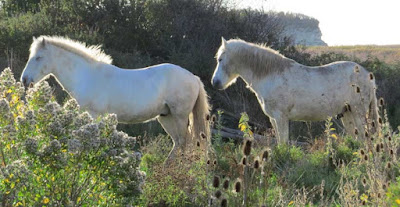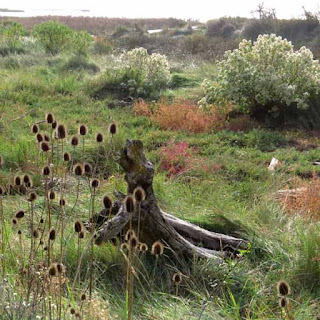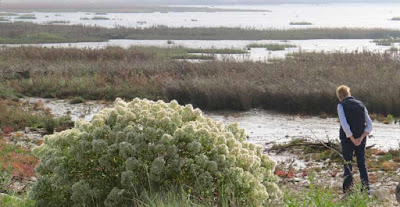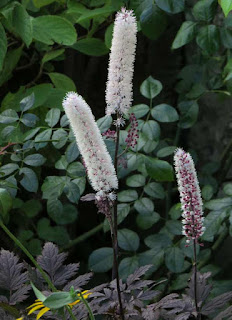"Leaves rustle and spill yourselves
Ever more splendidly, ever more recklessly..."
- Boris Pasternak
 |
| Our neighbour's lake, with lichen-decorated ash trees |
As I write this, on a foggy day in mid-November, most of the glorious autumn colour has already fallen from our trees and is collecting in layers on the ground to provide nutritious leaf-mould for next year.
 |
| Birches mingling with maple on the lakeside |
Our neighbour, Robert, always encourages us to wander around the lake and river on his property where he and Aurelien, his son, have toiled to grow many different trees and shrubs over the past decade.
Sadly, his son died of cancer over a year ago now, but their maturing arboretum stands testimony to Aurelien's enthusiasm for growing and grafting new trees to produce an amazing palette of colours for all of us to enjoy.
I see him every time I walk through the watery landscape that inspired him, whilst trying in vain to remember all the names he gave me for his trees and cultivars...
He's left us an important legacy, especially now we see that ash-dieback disease has reached this part of France.
During the past week Robert has had to cut down several of the trees bordering his lake but fortunately he can fill these gaps straight away with other saplings from his son's plantation.
Aurelien was particularly keen to cultivate North American varieties of ash and maple which would put on a great show of red and yellow leaves. He'd have been thrilled this year as the spectacle started early and just got better and better.
I can hear his voice urging me to take more photos and record all his new specimens!
As someone who used to cycle around Kew Gardens on quiet autumn mornings, armed with a camera and tripod in search of vivid leaf tones, I've been inspired by this continuing play of light and movement and colour.
Bravo Aurelien!
 |
| Paperbark birch |
During the past week Robert has had to cut down several of the trees bordering his lake but fortunately he can fill these gaps straight away with other saplings from his son's plantation.
Aurelien was particularly keen to cultivate North American varieties of ash and maple which would put on a great show of red and yellow leaves. He'd have been thrilled this year as the spectacle started early and just got better and better.
 |
| A small acer lights up a corner |
As someone who used to cycle around Kew Gardens on quiet autumn mornings, armed with a camera and tripod in search of vivid leaf tones, I've been inspired by this continuing play of light and movement and colour.
Bravo Aurelien!
 |
| A great autumn for berries too |
 |
| Strawberry tree - Arbutus unedo shaking off the latest shower |
Back in our own rather more subdued garden, we also have a gift of berries on our three different pyracantha bushes - red, yellow and orange.
Plus we now have scarlet berries on the cotoneaster which arrived by bird from a neighbour's plot!
Our favourite, though, is probably the strawberry tree which manages to produce fruit and flowers at the same time.
Plus we now have scarlet berries on the cotoneaster which arrived by bird from a neighbour's plot!
Our favourite, though, is probably the strawberry tree which manages to produce fruit and flowers at the same time.
 |
| Sudden rainstorm in early November |
This is a month of changeable and contrasting weather: rain, then very bright sun; heavy grey skies, followed by strong wind; early morning mist and fog - we run the gamut, but mostly it has remained mild and provided excellent conditions for moving plants around the garden.
 |
| Pot with lobelia and nicotiana |
Tidying away fallen leaves - into the leaf bin - allows us to see our perennials more clearly and decide how they can best be spread out, mixing and matching with other plants, trying new combinations.
There's virtually nothing that can't be moved at this time of year. And, of course, I always have a few potted-up seedlings which need to find a home.
Talking of seeds, four of the best examples I've grown recently can be seen in this photo, taken in an area of the back garden which still gets some sun
Behind the pot you can see the mauve heads of Dianthus superbus, which came into flower for the second time a few weeks ago. (This is just one of many excellent species we've grown from Chiltern Seeds and has been admired by several people.)
To the right of that pot, the silvery foliage spilling out from our raised bed is another seed from Chiltern's - Cerastium tomentosum var. columnae - which flowered in May and spreads itself naturally across the gravel drive. It will eventually die down in cold, wet weather but comes back again in spring.
 |
| Feathery Dianthus superbus |
 |
| Back garden, still showing some colour from leaves and berries |
Lobelia 'Blue Fountain' has been gracing our pots since July, in tandem with Nicotiana 'Lime Green' - this particular flower came up from a seed deposited in the pot earlier this summer!
The other side of the garden gets very little sun in winter so its structure becomes all-important. As shrubs on the back border lose their leaves, we're compensated with a sunny view of the fields and hill beyond.
That unknown rose cutting I took less than a year ago continues to provide a succession of blooms and is gradually clambering up its new tripod.
Flowering alongside it is an unseasonal echinacea which has managed to perform despite a lack of direct sunlight.
These days, it's not unusual to hear gardeners say that their plants are flowering at odd times. In addition to leaves turning early this autumn, we noticed that our Mahonia japonica is already in full bloom - something we normally look forward to in midwinter.
On the other hand, exotic sages like Salvia elegans have been quite slow to flower and have only recently come into their prime.
It makes us appreciate them all the more now that they're holding sway over other retreating plants and providing slashes of vivid colour to compete with the berries.
Salvias like these are invaluable in late autumn because they radiate so much fiery energy in a gardenscape which is beginning to wilt and head downhill to winter.
The ones with red flowers are probably unmatched for their exuberance, come rain or shine, but the blue shades have a velvet intensity which I also find quite compelling.
Salvia 'Indigo Spires' has some of the longest flower spikes I've ever seen - well over a foot in many cases - and Salvia leucantha (purple and white flowers) has the fluffiest spikes imaginable.
I've photographed and written about all these sages in previous autumn postings and they're deservedly popular plants for being long-flowering and trouble-free. Like many herbs, they come readily from cuttings and it's easy to increase your stock and put on a really dramatic show!
The other side of the garden gets very little sun in winter so its structure becomes all-important. As shrubs on the back border lose their leaves, we're compensated with a sunny view of the fields and hill beyond.
That unknown rose cutting I took less than a year ago continues to provide a succession of blooms and is gradually clambering up its new tripod.
Flowering alongside it is an unseasonal echinacea which has managed to perform despite a lack of direct sunlight.
 |
| Salvia elegans |
On the other hand, exotic sages like Salvia elegans have been quite slow to flower and have only recently come into their prime.
It makes us appreciate them all the more now that they're holding sway over other retreating plants and providing slashes of vivid colour to compete with the berries.
 |
| Salvia elegans making a bold statement in the cottage garden |
Salvias like these are invaluable in late autumn because they radiate so much fiery energy in a gardenscape which is beginning to wilt and head downhill to winter.
The ones with red flowers are probably unmatched for their exuberance, come rain or shine, but the blue shades have a velvet intensity which I also find quite compelling.
Salvia 'Indigo Spires' has some of the longest flower spikes I've ever seen - well over a foot in many cases - and Salvia leucantha (purple and white flowers) has the fluffiest spikes imaginable.
I've photographed and written about all these sages in previous autumn postings and they're deservedly popular plants for being long-flowering and trouble-free. Like many herbs, they come readily from cuttings and it's easy to increase your stock and put on a really dramatic show!
 |
| Robert's sheep and goats grazing alongside the river |










































